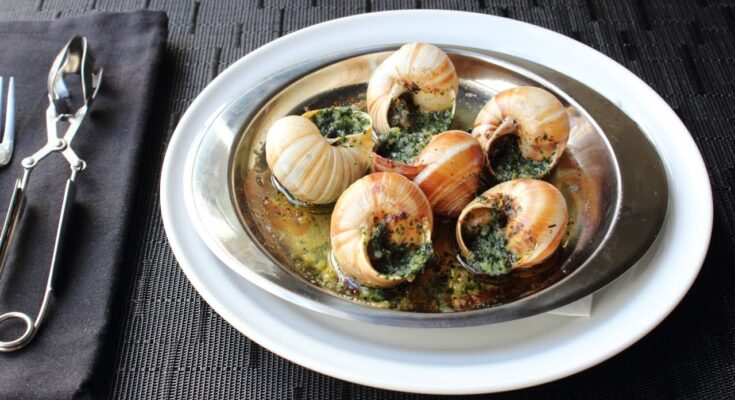Escargot Recipe: Escargot is one of those dishes that instantly transports you to the heart of French cuisine. When you hear the word, you probably imagine candlelit dinners in Paris, elegant dining tables, and a delicacy enjoyed by true food lovers. But what exactly is escargot? Put simply, escargot is the French word for edible snails. While it might sound unusual to some, this dish has been part of French culinary traditions for centuries and is still celebrated worldwide today.
Snails have been eaten since ancient times, with records showing that the Romans enjoyed them as a luxury meal. Over the years, escargot has become more than just food—it represents sophistication and cultural heritage. When cooked the traditional way with garlic butter, parsley, and herbs, escargot transforms into a dish that surprises newcomers with its rich, savory flavor.
Why is escargot considered a delicacy? It’s not just about the taste—it’s about the experience. Preparing escargot takes patience, the right ingredients, and a bit of culinary artistry. Eating it also feels ceremonial, especially when served in shells with little tongs and forks. If you’ve never tried escargot before, this recipe guide will walk you through everything you need to know to prepare it at home like a professional chef.
Health Benefits of Eating Escargot
Many people are surprised to learn that escargot isn’t just delicious—it’s also incredibly healthy. Unlike other rich French dishes, escargot is actually light on calories and packed with nutrients.
Snails are naturally high in protein, which makes them a great option for anyone looking to build or maintain muscle. Just 100 grams of escargot contains around 16 grams of protein, similar to what you’d get from lean meat like chicken or fish. They are also an excellent source of minerals, particularly iron, magnesium, and selenium. These minerals play vital roles in supporting healthy blood, strong bones, and a robust immune system.
Another surprising benefit is that escargot is very low in fat. Unlike red meats, snails are lean and keto-friendly, making them a great choice for anyone on a low-carb diet. When combined with garlic and herbs, escargot becomes both flavorful and nutrient-rich without being overly heavy.
It’s also worth noting that escargot contains essential fatty acids, which are beneficial for heart health. So, while it may seem indulgent, eating escargot can actually support a balanced and health-conscious diet. The key is in the preparation—when cooked with the right balance of butter, garlic, and herbs, it’s both delicious and nourishing.
Ingredients You’ll Need
To prepare escargot at home, you’ll need a few essential ingredients. Luckily, most of them are easy to find, especially if you opt for canned escargot instead of fresh snails. Here’s what you’ll need:
- Snails (Escargot): You can use either fresh snails (which require more prep work) or canned escargot (a convenient option).
- Garlic: Fresh garlic cloves are essential for making the buttery sauce.
- Unsalted Butter: Rich, creamy butter is the heart of the escargot recipe.
- Parsley: Fresh parsley adds a bright, herbaceous flavor.
- Shallots: Finely chopped shallots give depth to the sauce.
- White Wine (optional): Adds acidity and enhances the overall flavor.
- Salt and Pepper: For seasoning.
- Lemon Juice (optional): Brightens up the dish with a touch of acidity.
Tools and Equipment:
- Escargot shells or small oven-proof dishes
- Escargot tongs and forks (for serving)
- Baking tray
- Mixing bowl and whisk
These simple ingredients and tools will allow you to create a dish that looks and tastes as though it came straight from a French restaurant.
Preparing Snails for Cooking
The preparation step largely depends on whether you’re using fresh or canned snails.
If you’re working with fresh snails, you’ll need to clean them thoroughly. This involves purging them by feeding them a diet of clean vegetables for several days, then rinsing and boiling them to remove any impurities. It’s a labor-intensive process, but it ensures that the snails are safe to eat and have the right flavor. After cleaning, the snails are usually removed from their shells, which can later be reused for serving.
For canned escargot, the process is much simpler. These snails are pre-cooked and ready to use, so all you need to do is drain them and pat them dry. They can then be stuffed into shells or baked in small ramekins with garlic butter.
Another important step is preparing the escargot shells if you’re using them. Wash and sterilize the shells before stuffing them with the snails and garlic butter mixture. If shells aren’t available, you can use small ceramic dishes or puff pastry for a modern twist.
By taking time to prepare the snails properly, you set the foundation for a dish that’s not only flavorful but also safe and enjoyable to eat.
Step-by-Step Guide to Cooking Escargot
Cooking escargot may sound complicated, but once you break it down into steps, it becomes surprisingly manageable. The most traditional recipe involves garlic butter, parsley, and white wine. Here’s a simple guide to help you master the process:
Step 1 – Preparing Garlic Butter Mixture
In a bowl, combine softened butter, minced garlic, finely chopped shallots, fresh parsley, a splash of white wine, salt, and pepper. Mix until smooth. This fragrant mixture will form the base of the dish.
Step 2 – Stuffing Snails into Shells
Place one snail into each shell (or ramekin) and spoon the garlic butter mixture on top, making sure the snail is fully coated.
Step 3 – Baking Escargot to Perfection
Preheat your oven to 375°F (190°C). Arrange the shells or ramekins on a baking tray and bake for about 10–12 minutes until the butter is bubbling and aromatic.
Step 4 – Serving Escargot with Style
Serve hot with crusty French bread to soak up the flavorful butter. If you have escargot tongs and forks, use them for an authentic French dining experience.
This classic method is foolproof and always a crowd-pleaser.
Different Variations of Escargot Recipes
While the classic garlic butter escargot is a timeless favorite, there are many ways to get creative with this dish. Depending on your preferences, you can experiment with flavors to suit your taste buds. Here are some delicious variations you can try:
Escargot with White Wine Sauce
This variation builds on the traditional garlic butter but takes it a step further with a luxurious white wine sauce. After preparing your garlic butter mixture, add a splash of dry white wine and let it simmer briefly in a pan. The wine adds acidity and brightness, balancing out the richness of the butter. Once the sauce is ready, spoon it over the snails and bake them as usual. The result is a sophisticated dish with deeper flavor layers.
Escargot in Puff Pastry
If you’re looking for a creative and modern twist, escargot in puff pastry is a great option. Instead of baking the snails in shells, you wrap them in puff pastry pockets filled with garlic butter and herbs. Once baked, the pastry becomes golden and flaky, while the snail inside remains tender and juicy. This version is perfect for dinner parties or as an elegant appetizer.
Spicy Garlic Escargot
For those who love a little heat, adding chili flakes or cayenne pepper to the garlic butter transforms escargot into a bold, spicy treat. The heat pairs beautifully with the richness of butter and garlic, giving a fiery kick to a traditionally mild dish. This variation works especially well if you’re serving escargot alongside robust red wines or spiced side dishes.
The beauty of escargot is its versatility—you can adapt it to your own preferences without losing its essence. Whether you prefer traditional French style or experimental fusions, escargot offers endless culinary possibilities.
Tips for Perfect Escargot Every Time
Cooking escargot may seem intimidating, but with the right techniques, you can achieve restaurant-quality results at home. Here are some essential tips:
Choosing the Right Snails
The foundation of a good escargot dish is the snail itself. If you can find fresh snails, choose ones that are firm and plump. If fresh isn’t available, canned escargot is perfectly fine—it’s convenient and still delivers excellent flavor when prepared correctly.
Seasoning Balance
One of the most common mistakes is using too much garlic or butter, which can overwhelm the delicate flavor of the snail. Balance is key. A mix of garlic, butter, parsley, shallots, and a touch of lemon juice creates the perfect harmony. Remember, the goal is to enhance the snail’s flavor, not mask it.
Baking Temperature and Time
Overcooking can ruin escargot by making it rubbery. The ideal temperature is 375°F (190°C) for about 10–12 minutes. You’re not cooking the snail itself—it’s already pre-cooked in most cases—you’re simply heating it through and melting the garlic butter for maximum flavor.
Following these tips will ensure your escargot turns out flavorful, tender, and absolutely delicious every single time.
Pairing Escargot with Wine and Side Dishes
A dish as elegant as escargot deserves the right pairings. The right wine and sides can elevate your dining experience to a whole new level.
Best Wines to Serve with Escargot
Traditionally, escargot is paired with dry white wines such as Chablis, Sauvignon Blanc, or Chardonnay. These wines complement the buttery richness of the dish without overpowering it. If you prefer red, go for a light-bodied option like Pinot Noir, which pairs well with the earthy undertones of the snails.
Complementary Side Dishes
Escargot is often served as an appetizer, but you can make it part of a full meal with the right sides. Crusty French bread is a must for soaking up the garlic butter. Light salads with vinaigrette, roasted vegetables, or even creamy mashed potatoes work beautifully as accompaniments.
Creating a French-Inspired Meal
If you want to serve escargot in true French style, start with a glass of champagne, follow with escargot as an appetizer, and then serve a main dish like coq au vin or beef bourguignon. Finish with crème brûlée or macarons for dessert. This creates an authentic French dining experience right at home.
Pairing escargot thoughtfully not only makes the dish shine but also adds an air of sophistication to your meal.
Common Mistakes to Avoid When Cooking Escargot
Even though escargot seems simple once you get the hang of it, there are common pitfalls that beginners (and even some experienced cooks) fall into. Here’s what to watch out for:
Overcooking the Snails
This is the number one mistake. Overcooking makes snails tough and rubbery, which can turn off first-time eaters. Always stick to the recommended cooking time.
Using Too Much Garlic or Butter
While garlic butter is the star of the dish, too much of it can completely mask the subtle flavor of the snails. Keep the balance—enough to enhance but not overwhelm.
Not Cleaning the Snails Properly
If you’re using fresh snails, improper cleaning can ruin the entire dish. Make sure they’re purged, rinsed, and boiled correctly. If you’re new to escargot, starting with canned snails is the safest and easiest option.
By avoiding these mistakes, you’ll ensure that your escargot is tender, flavorful, and enjoyable—even for first-timers.
Serving Suggestions and Presentation Ideas
Escargot is more than just a dish—it’s an experience. The way you present it can transform an ordinary meal into something memorable and sophisticated. Whether you’re preparing it for a romantic dinner or a festive gathering, here are some serving ideas to impress your guests.
Traditional French Style Serving
The most classic way to serve escargot is in their shells, filled with garlic butter and placed in a special escargot dish with small indentations. Each shell is held in place, preventing the buttery sauce from spilling. Guests are usually provided with escargot tongs to hold the shell steady and a small two-pronged fork to extract the snail. This method feels authentic and elegant, instantly transporting diners to a Parisian café.
Modern Restaurant-Style Presentation
If you don’t have access to shells, ramekins or small cast iron skillets are excellent alternatives. You can bake the escargot in bubbling garlic butter and serve them directly in these dishes, garnished with fresh parsley and a squeeze of lemon. This approach is chic, practical, and far less fussy for beginners.
Serving Escargot at Dinner Parties
For a more playful twist, serve escargot in bite-sized puff pastry cups or even on small toasted baguette slices. These finger-friendly options are perfect for cocktail parties or gatherings where guests can mingle and enjoy without formal utensils. Arrange them neatly on a platter, and you’ve got yourself a luxurious appetizer that will have everyone talking.
No matter which presentation style you choose, don’t forget the bread. A warm, crusty baguette is essential for soaking up the flavorful garlic butter sauce—it’s almost as important as the snails themselves!
Storing and Reheating Escargot
Escargot is best enjoyed fresh out of the oven, but if you have leftovers, you can store and reheat them properly without losing too much flavor.
How to Store Leftover Escargot
Place any leftover escargot in an airtight container and refrigerate them within two hours of cooking. Stored properly, they can last up to 2 days in the fridge. Keep in mind that the butter may solidify, which is perfectly normal.
Reheating Without Losing Flavor
To reheat escargot, preheat your oven to 300°F (150°C) and warm them gently for about 8–10 minutes. Avoid microwaving, as it can make the snails rubbery and unevenly heated. For the best results, add a little extra garlic butter before reheating to refresh the flavors.
Freezing Snails for Later Use
If you’re planning ahead, you can freeze uncooked, butter-stuffed snails in their shells. Simply arrange them on a tray, freeze until solid, and then transfer them to a freezer-safe bag. They can be kept for up to 3 months. When you’re ready to enjoy them, bake straight from frozen—just add a couple of extra minutes to the cooking time.
These storage and reheating tips ensure you can enjoy escargot at its best, even if you prepare them in advance or have leftovers.
Escargot for Beginners – Overcoming the Fear Factor
For many people, the idea of eating snails feels intimidating. After all, it’s not a common food in most households. But once you get past the initial hesitation, escargot can become one of your favorite delicacies.
First-Time Tips for Trying Snails
If it’s your first time, go with the traditional garlic butter recipe. The familiar flavors of garlic, butter, and parsley make the dish approachable and delicious. Pair it with bread and wine to create a relaxed atmosphere.
How to Introduce Escargot to Guests
If you’re serving escargot at a dinner party, ease your guests into the experience by explaining the history and delicacy of the dish. Present it attractively, and encourage them to try just one. Often, the first bite is all it takes to win someone over.
Making Escargot Approachable
Instead of serving snails in their shells, try puff pastry or ramekins. These presentations feel less intimidating and make the dish look more like a familiar appetizer than something exotic.
Remember, escargot is about adventure in dining. Trying it is like stepping into another culture’s traditions—once you taste it, you may wonder why you waited so long.
Escargot Around the World
Although escargot is most famous in France, it has found its way into cuisines around the world. Each region puts its own twist on the dish, making it unique.
Escargot in French Culture
In France, escargot is a symbol of culinary tradition and is often served during festive occasions like Christmas and New Year. French escargot is usually prepared with garlic butter, parsley, and sometimes wine. It’s not just a dish but a cultural ritual that brings families together around the table.
Escargot in Mediterranean Cuisine
In Mediterranean countries like Spain and Italy, snails are also popular, but the preparations differ. In Spain, “caracoles” are often simmered in rich tomato-based sauces with herbs and spices. In Italy, they may be stewed with wine and served with polenta or pasta.
Escargot as a Global Delicacy
Beyond Europe, escargot has gained popularity in fine-dining restaurants worldwide. From the United States to Asia, chefs are experimenting with modern twists—adding unique flavors like truffle, miso butter, or curry spices. This global popularity proves that escargot has evolved from a French specialty into a true international delicacy.
FAQs about Escargot Recipe
1. Can I use frozen snails for escargot?
Yes, frozen snails can be used. Just make sure to thaw them properly before cooking.
2. How do I know when escargot is fully cooked?
If using pre-cooked canned snails, you’re mainly reheating them. They’re ready when the butter is bubbling and the snails are warmed through.
3. What does escargot taste like?
Escargot has a mild, earthy flavor with a texture similar to mushrooms or shellfish. Most of the taste comes from the garlic butter sauce.
4. Can I make escargot without shells?
Absolutely. You can bake them in ramekins, puff pastry, or even serve them on toasted bread.
5. Is escargot healthy to eat regularly?
Yes, escargot is high in protein, low in fat, and packed with essential minerals. Just be mindful of the butter if you’re watching calories.
Conclusion
Escargot is much more than just snails on a plate—it’s a cultural experience, a symbol of elegance, and a dish that surprises with its rich flavors. From understanding the history and health benefits to mastering the step-by-step cooking guide, you now have everything you need to prepare this French delicacy at home.
Whether you stick to the traditional garlic butter recipe or try creative variations like puff pastry or spicy escargot, the key is balance—enhancing the natural taste of the snail without overpowering it. Pair it with a good wine, serve it with style, and you’ll have a dish that impresses every time.
If you’ve never tried escargot before, now’s the perfect time to embrace the adventure. Who knows? It might just become one of your new favorite recipes.



